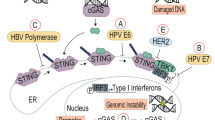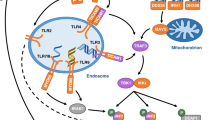Abstract
Induction of expression of the tumor suppressor p53 after interferon treatment has been recently demonstrated (Takaoka et al., 2003), suggesting an antiviral activity of the protein. In addition, a direct correlation between p53 levels and tumor resistance has been addressed by generating mice with an extra copy of p53 (‘super p53’ mice) (Garcia-Cao et al., 2002). Here, we show that vesicular stomatitis virus replication in mouse embryo fibroblasts derived from ‘super p53’ mice is impaired as a result of apoptosis induction via p53 activation. These findings unequivocally demonstrate an antiviral activity of p53, a process that may contribute to inhibit the spread of the virus in vivo.
This is a preview of subscription content, access via your institution
Access options
Subscribe to this journal
Receive 50 print issues and online access
$259.00 per year
only $5.18 per issue
Buy this article
- Purchase on Springer Link
- Instant access to full article PDF
Prices may be subject to local taxes which are calculated during checkout



Similar content being viewed by others
References
Balachandran S and Barber GN . (2000). IUBMB Life, 50, 135–138.
Balachandran S, Porosnicu M and Barber GN . (2001). J. Virol., 75, 3474–3479.
Clemens MJ . (2003). J. Interferon Cytokine Res., 23, 277–292.
Dobner T, Horikoshi N, Rubenwolf S and Shenk T . (1996). Science, 272, 1470–1473.
Feitelson MA, Zhu M, Duan LX and London WT . (1993). Oncogene, 8, 1109–1117.
Gadaleta P, Vacotto M and Coulombie F . (2002). Virus Res., 86, 87–92.
Garcia-Cao I, Garcia-Cao M, Martin-Caballero M, Criado LM, Klatt P, Flores JM, Weill JC, Blasco MA and Serrano M . (2002). EMBO J., 21, 6225–6235.
Giedlin MA, Cook DN and Dubensky Jr TW . (2003). Cancer Cell, 4, 241–243.
Gonzalo JA, Gonzalez-Garcia A, Kalland T, Hedlung G, Martinez C and Kroemer G . (1994). Eur. J. Immunol., 24, 48–52.
Humlova Z, Vokurka M, Esteban M and Melkova ZJ . (2002). J. Gen. Virol., 83, 2821–2832.
Kao CC, Yew PR and Berk AJ . (1990). Virology, 179, 806–814.
Kirn D, Martuza RL and Zwiebel J . (2001). Nat. Med., 7, 781–787.
Kopecky SA, Willingham MC and Lyles DS . (2001). J. Virol., 75, 12169–12181.
Lane DP and Crawford L . (1979). Nature, 278, 261–263.
Levine AJ . (1997). Cell, 88, 323–331.
Li M and Beg AA . (2000). J. Virol., 74, 7470–7477.
Linzer DI and Levine AJ . (1979). Cell, 17, 43–52.
Ljungman M . (2000). Neoplasia, 2, 208–225.
Pluquet O and Hainaut P . (2001). Cancer Lett., 174, 1–15.
Samuel CE . (2001). Clin. Microbiol. Rev., 14, 778–809.
Scheffner M, Takahashi T, Huibregtse JM, Minna JD and Howley PM . (1992). J. Virol., 66, 5100–5105.
Smith GL, Symons JA, Khanna A, Vaderplasschen A and Alcami A . (1997). Immunol. Rev., 159, 137–154.
Speir E, Modali R, Huang ES, Leon MB, Shawl F, Finkel T and Epsteins E . (1994). Science, 265, 391–394.
Stojdl DF, Lichty B, Knowles S, Marius R, Atkins H, Sonenberg N and Bell JC . (2000). Nat. Med., 6, 821–825.
Sur JH, Allende R and Doster AR . (2003). Vet. Pathol., 40, 512–520.
Szekely L, Selivanova G, Magnusson KP, Klein G and Wiman KG . (1993). Proc. Natl. Acad. Sci. USA, 90, 5455–5459.
Takaoka A, Hayakawa S, Yanai H, Stoiber D, Negishi H, Kikuchi H, Sasaki S, Imai K, Shibue T, Honda K and Taniguchi T . (2003). Nature, 424, 516–523.
Wagner RR and Rose JK . (1996). Fields Virology, 3rd edn. Fields BN, Knipe DM and Howley PM (ed). Lippincott-Raven Publishers: Philadelphia, PA.
Acknowledgements
We thank Victoria Jimenez for technical assistance on culture cells and viruses. We also thank Maribel Muñoz for great animal assistance. Work at the laboratory of M Serrano has been funded by the Spanish Ministry of Science and Technology (SAF2002-03402), and by the European Union (QLRT-2000-02084, QLRT-2000-00616 and INTACT). C Rivas laboratory work was supported by a grant from Ministerio de Ciencia y Tecnologia de España (BIO2002-02417). C Rivas is an investigator of the Ramon y Cajal Programme.
Author information
Authors and Affiliations
Corresponding author
Rights and permissions
About this article
Cite this article
Mun̄oz-Fontela, C., Angel Garcia, M., Garcia-Cao, I. et al. Resistance to viral infection of super p53 mice. Oncogene 24, 3059–3062 (2005). https://doi.org/10.1038/sj.onc.1208477
Received:
Revised:
Accepted:
Published:
Issue Date:
DOI: https://doi.org/10.1038/sj.onc.1208477
Keywords
This article is cited by
-
Translating p53-based therapies for cancer into the clinic
Nature Reviews Cancer (2024)
-
Reestablishment of p53/Arf and interferon-β pathways mediated by a novel adenoviral vector potentiates antiviral response and immunogenic cell death
Cell Death Discovery (2017)
-
Tumor suppressor p53 protects mice against Listeria monocytogenes infection
Scientific Reports (2016)
-
Emerging roles of p53 and other tumour-suppressor genes in immune regulation
Nature Reviews Immunology (2016)
-
Transcriptional analysis of immune-related gene expression in p53-deficient mice with increased susceptibility to influenza A virus infection
BMC Medical Genomics (2015)



